Airfare Hacks 2 – The Real Way to Score Cheap Airfare
There’s a lot of so-called science about booking cheap airfares, some of it (like the assertion that airfares are cheapest at the beginning of the week) mostly-true, some of it (that 3-months-in-advance is a “sweet spot”, or that certain weekdays are always cheaper to fly) dubious.
Luckily, we don’t need folklore. We have Kayak. (With whom, I should emphasize, I have no affiliation.) Or other aggregator sites. It doesn’t matter which you use, as long as it does two things: 1) aggregate results from multiple travel sites, and 2) include some type of “flexible date optimizer”. With those tools, and fare alerts, there’s no need to throw caution-to-the-wind. We can use software smart people have already designed for us to look at hard numbers.
In the first Airfare Hacks Article, I described a situation in which the searcher has a few destinations in mind, and about a month range to play with. That’s an ideal situation if you’re deciding three-months-out which weeks to take-off for vacation, and where to go, and even though it seems obvious I felt it bore repeating that considering multiple scenarios in parallel could save you amounts in the high-three-figures (when you add the cost of two tickets), and give you more autonomy over your air carrier choices.
Sometimes, of course, we don’t have the luxury of so much flexibility. Maybe we’re flying home for the holidays – or anywhere over a holiday – have a convention or wedding to attend, or are otherwise locked into firm dates with very little wiggle room. How do we use technology to test much-bandied assumptions about hacking airfare, and maximize our chances of a good deal?
Over the last several months I’ve been conducting research and running experiments and here’s what I’ve found-
For holiday travel, there’s little reason not to book six-months-or-more in advance.
I’ll let the industry insiders try to explain the economics. (Though it seems obvious that holiday travel is a guaranteed payday, so there’s less incentive to hold onto cheap seats in case airlines need to fill their planes.) This is a principle that at least a few real experts espouse, and experimentation has shown it to be true in all the cases I’ve tested. Fares on the non-peak-travel dates I was watching oscillated up-and-down, sometimes until just weeks before the departure date, whereas holiday fares mostly marched steadily up.
Let’s back up. How do I know this? I chose several destinations – some real and some hypothetical – to watch, and checked them intermittently as the hypothetical travel dates got closer. Want to go to Hong Kong in August? As of press time, you can still score a fare of just over $1000, if you choose your dates well (more on this below). Want to go over Christmas? With some caveats, book asap, because fares were in the $1300s last month, the $1500s last week, and headed toward the $1700s as of this writing.
(The Asia trip, incidentally, is for this site’s soon-to-launch companion site, Smart Asia Travel.)
The Date Optimizer
Which day is cheapest to leave? Wednesday? Saturday? Well, it varies. But if your preferred travel site has date-optimization, you don’t have to do much guess work. Even the most restrictive itinerary has a little wiggle room. If you can leave on Wednesday morning, you can probably leave on Thursday morning. And the fare savings can be significant.
There are two ways you can use Kayak’s date optimization software. The first is automatic. As long as you’ve cleared your browser cookies, the first time you enter in destinations in the “flights” category and place your cursor in the “depart” field, an interactive calendar will open on the right side of the screen.
You can use this as a guideline for the departure and return dates. For instance, if you needed to leave the second week of September sometime between Monday and Thursday, you would see instantly that Wednesday was the cheapest day to depart, by at least $100.
If this seems like a crude tool, not-to-worry. Once you run the initial search, you can “tweak” your dates more precisely. Say in this hypothetical I selected a Wednesday-to-Wednesday trip, leaving the 11th and returning the 18th. I’ll run the fare search, and then click on the “prong-shaped” icon in the top right quadrant of the screen, where the mouseover description says “show flexible date charts”.
Once you click into the date charts, you can quickly double-check if your dates are the cheapest by advancing the departure and arrival dates and watching the height of the bars change.
Advancing the departure date 1-2 days prior, then 1-2 days ahead, then repeating the process with the return date, quickly confirms that we’re in the “sweet spot” for this date range.
It’s worth mentioning that if you’re traveling domestically and want to use a “premium” carrier like JetBlue or Virgin America, the above step is not necessary, since the sites of those carriers will display all fares leaving with a few days’ range, and this transparency means the prices tend to follow a more predictable pattern – with cheap fares vanishing first, and in order of cheapness – than those of the mainline carriers.
Now it’s time to discuss the second Kayak tool that will help you cut through the bunk.
The Trend Line and Fare Predictor
These tools are both immediately self-evident to any user of the site, and probably obvious to any varsity traveler. Still, it’s useful to be reminded. On the left side of the screen is the trend-line and fare predictor. One glance at this and it’s obvious the conventional wisdom of “always book 3 months/6 weeks/whatever in advance” is hogwash. This is just a hypothetical, but the fare I’m searching is one month away and the trend line shows more-or-less steady oscillation for the last 3-4-months.
In this case Kayak is advising us to wait before buying. Now it’s time to cull all of this together into a coherent fare-searching strategy.
1. Whenever possible, start looking around 3 months in advance for non-holiday travel, 6 months for holiday travel.
We’ve seen that for some fares the lead time makes scant difference – in the screenshot above you can see cheapest fare actually occurred the week of July 23, about 6-weeks-out, but that fares appear to be headed for the $1000 mark again. The reason we’re giving ourselves 3 months is to get a baseline picture of the “peaks and valleys” of the fare cycle so we buy early with reasonable confidence that even if fares nosedive they’re not going to get much cheaper than what we paid.
2. Use the date optimization feature to pinpoint the cheapest days to travel, then set fare alerts.
Kayak allows you to set up a price alert – the option is just above the trend line in the upper left-hand corner of the fare results window.
Use this feature to set up weekly – or, if you prefer and you’re OCD like me, daily – fare alerts. (I went a little overboard and made spreadsheets and graphs of the fare trends, but you don’t have to – Kayak does all the work for you.) When you receive the email, click back to the saved itinerary, and have a look at the price trend. Most non-peak-travel-season fares oscillate between two fairly-regular poles. Just identify the extremes, wait until fare hits a low point, and buy.
Oooor don’t buy yet, but try this varsity trick from Four Hour Chef author Tim Ferriss.
3. On the most optimal day to buy, to go Priceline, choose “name your price”, and start at 50% of the cheapest advertised fare.
Often it’s possible to score cheaper fares than those advertised. If you’re willing to go-deep, and have a sense of adventure, it’s worth a try.
Most travelers are familiar with Priceline, but there are several huge caveats. First, you commit to buying the seat if your bid is met, which means you enter credit card and passenger information up-front. Second, you forfeit any discretion over the airline. For domestic travel, that’s not such a big deal, since if you’re not using JetBlue or Virgin America, or participating in a frequent flyer program, all domestic carriers are pretty-much the same. (Delta, in my experience, is marginally better, but not worth paying extra.)
If, however, you’re traveling internationally, especially overseas, the difference between a carrier like United and one like Cathay Pacific or All Nippon Airways is huge. Service, meals, the size/shape/design of the seat, on-board entertainment options. (On one outbound Cathay flight I ate better-than-average Hong Kong noodles and sipped white wine. On the return leg, on AA, a male flight attendant handed me a foil-brick with tongs. When I asked what was for dinner, he answered “MEAT.”) In those cases, the Priceline hack may not be worth the money.
In summary, recurring themes are use data to test the best times to book rather than rely on “urban legends”, and make educated decisions about the best value, not just the cheapest fare, if you’re traveling internationally.
Happy hunting!

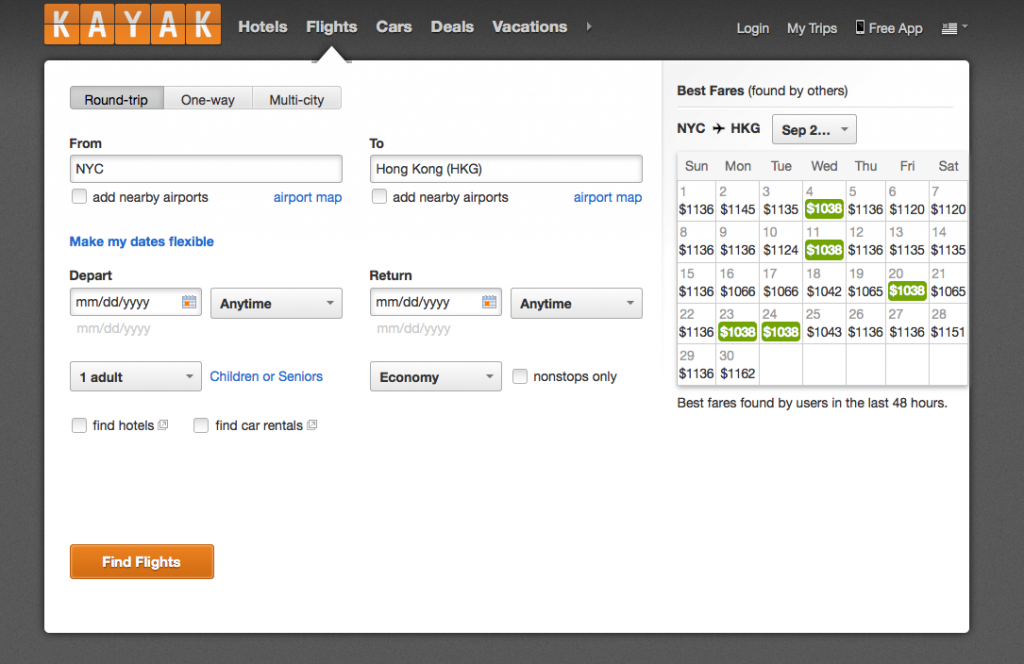

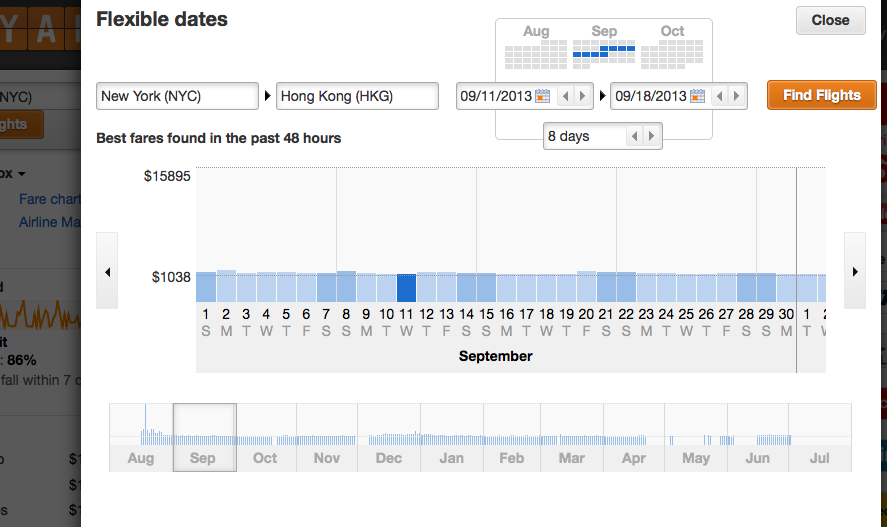
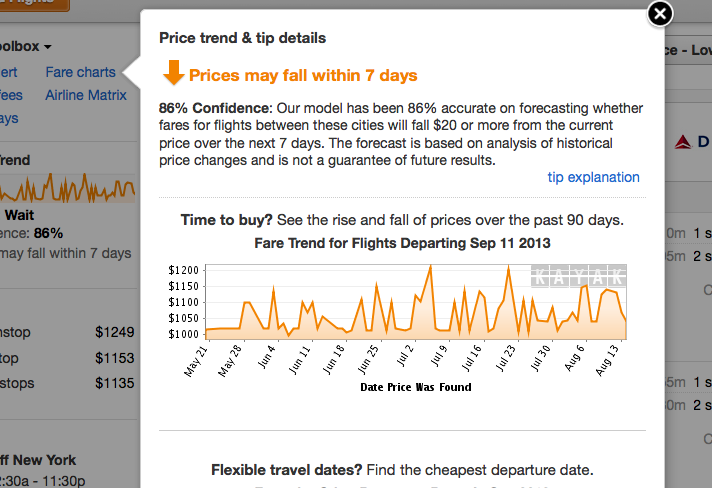
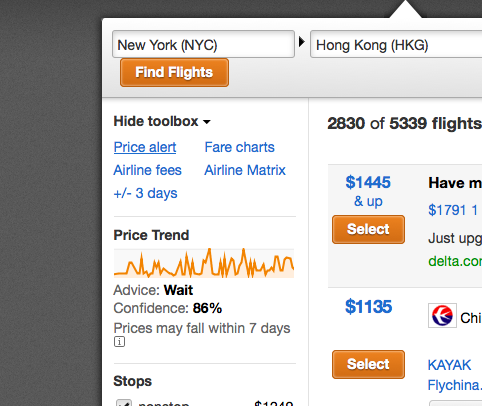
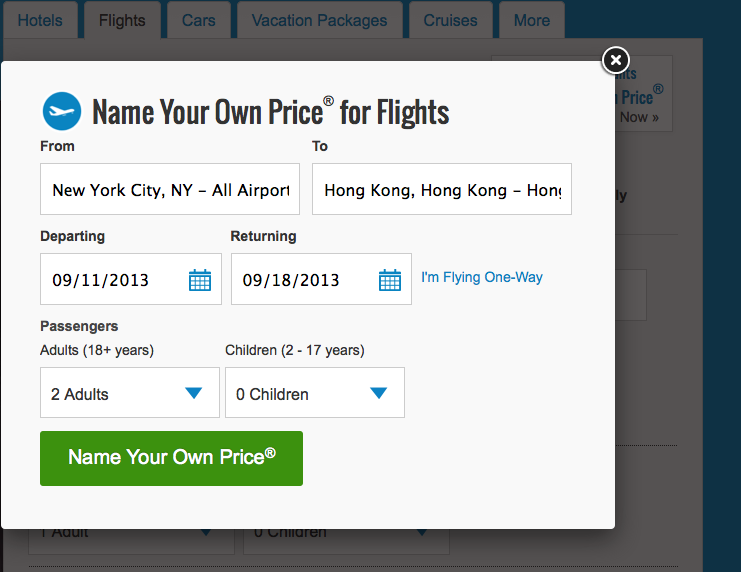
2 Comments
Eight Mistakes You're Probably Making When You Travel | Smart Getaways for Couples
August 16, 2013[…] would you? What if I told you you didn’t even have to do that? Click here, then here, to read in greater detail about Kayak, the real flexible dates hack, and choosing real value in […]
The Fare for That Itinerary is No longer Available | Smart Getaways for Couples
August 20, 2013[…] at least two other articles, I’ve lauded the virtues of Kayak, my favorite travel-site-aggregator. Kayak, unlike primary […]